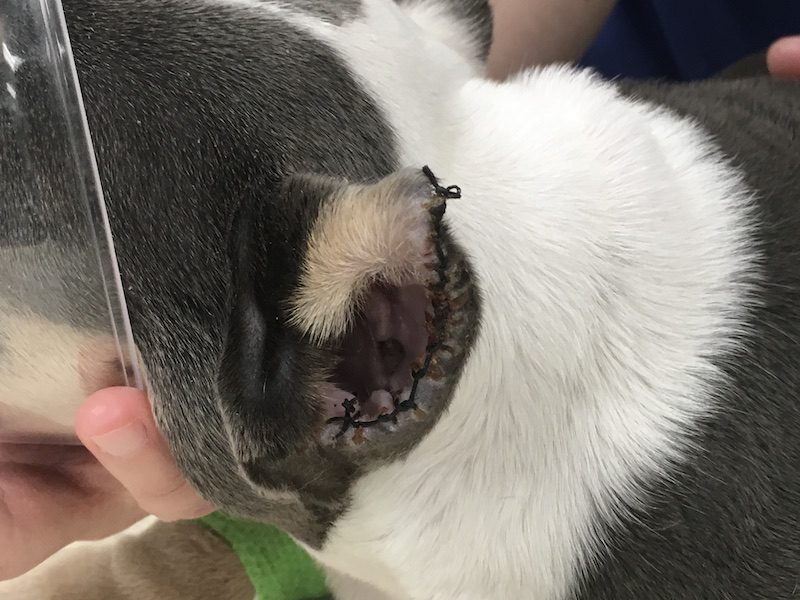
by David Caddell, Hospital Director
A referring veterinarian recently sent a puppy to our hospital in extremely critical condition. To the shock and sadness of our doctors and staff, it turns out the so-called “owners” of this puppy had cropped the puppy’s ears at home. Ear cropping is by no means a new issue, but the way this was done was heartbreaking. They used what we surmise was a razor blade or sharp knife; they used common sewing thread for suture; and they did it all without the use of any anesthetic.
A case of cruelty
During what was apparently the owner’s efforts to restrain the puppy while cropping its ears, the dog sustained severe internal injuries, leaving little to no hope that anything could be done to help or save it. Our team did what they could for the puppy, but recommended humane euthanasia; the owners, having already opted to forgo any medical treatment, agreed.

This puppy’s caretakers cropped its ears at home with no anesthetic. That’s sewing thread used as suture.
We were angry, heartbroken, and stunned at the cruelty perpetrated on a little puppy.
This case has had a profound impact on our team due to the senseless pain and suffering endured by another living creature only so it could “look” a certain way. Moreover, the impression our team derived from their interactions with the owners was one of an overriding concern of “money”. Everything was about money to them: they cropped the ears so they could sell the puppy for more money; they didn’t seek a veterinarian who would crop ears because that would be too much money; they withheld seeking treatment right away because they thought the puppy was OK and it would cost money; and they withheld treatments because it was too expensive.
We spoke with Animal Control and the investigator, while shocked, greatly appreciated our efforts to provide evidence the officer would need to pursue an animal cruelty case against the clients. Additionally, the Animal Control Office complimented our staff on how they handled the situation by setting their personal feelings aside so they could focus on the puppy and gather facts surrounding the case. Our team was able to pass on pictures, x-rays and medical records (which included statements made by the owners).
Shocking situations such as the one described above have raised questions about what we can do to educate the public at large regarding ear cropping.
Why crop ears at all?
There are a number of dog breeds known for cropped ears, including American Staffordshire Terriers, Boxers, Doberman Pinschers, and Great Danes. (See this blog from 2017 which explains the history of the practice and some pros and cons.)
The practice of cropping originated to keep the dog’s ears from being bitten or torn while going into tough situations. Looking through many breed’s histories you can see how this would be a useful practice. This is no longer needed in the present as dogs aren’t, for example, being sent into the front lines to carry supplies to soldiers, or to deal with vermin in barns and sheds. Now dogs are pets, our best friends and companions. However, many breeders—and potential owners—want to maintain the historical appearance of their breed so they continue practicing the physical alteration.

Cropped and erect ears are part of the Doberman Pinscher’s distinct look.
Changing attitudes toward cropping ears
An additional resource readers may want to consider is an article on ear cropping and tail docking published at Canine Journal in August of 2019. At the end of the article there is a graphic video showing an ear cropping procedure. It may be worth viewing so you know what the procedure entails.
In closing, we at the Ann Arbor Animal Hospital do not perform ear cropping procedures unless there is some type of necessary reason for doing so (injury to the ear, etc). Moreover, within the veterinary field, more and more veterinarians are refusing to perform ear croppings. Therefore, we encourage those people considering having their puppy’s ears cropped to first speak with their veterinarian before making a decision.
Recent Posts
About Us
Ann Arbor Animal Hospital is a locally-owned animal hospital operating for over 90 years in Ann Arbor, MI.
